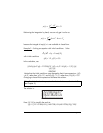
Page 16-15
Dirac’s delta function and Heaviside’s step function
In the analysis of control systems it is customary to utilize a type of functions that
represent certain physical occurrences such as the sudden activation of a switch
(Heaviside’s step function, H(t)) or a sudden, instantaneous, peak in an input to
the system (Dirac’s delta function, δ(t)). These belong to a class of functions
known as generalized or symbolic functions [e.g., see Friedman, B., 1956,
Principles and Techniques of Applied Mathematics, Dover Publications Inc.,
New York (1990 reprint) ].
The formal definition of Dirac’s delta function
, δ(x), is δ(x) = 0, for x ≠0, and
Also, if f(x) is a continuous function, then
An interpretation for the integral above, paraphrased from Friedman (1990), is
that the δ-function “picks out” the value of the function f(x) at x = x
0
. Dirac’s
delta function is typically represented by an upward arrow at the point x = x0,
indicating that the function has a non-zero value only at that particular value of
x
0
.
Heaviside’s step function
, H(x), is defined as
Also, for a continuous function f(x),
Dirac’s delta function and Heaviside’s step function are related by dH/dx =
δ(x). The two functions are illustrated in the figure below.
)].([lim)(lim
0
sFstff
st
⋅==
→∞→
∞
∫
∞
−∞
= .0.1)( dxx
δ
∫
∞
−∞
=− ).()()(
00
xfdxxxxf
δ
⎩
⎨
⎧
<
>
=
0,0
0,1
)(
x
x
xH
∫∫
∞
−∞
∞
=−
0
.)()()(
0
x
dxxfdxxxHxf


















